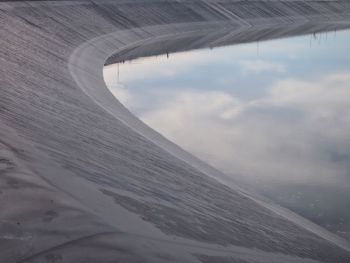Lining: Difference between revisions
Rmanwaring (talk | contribs) (Created page with "<!-- Delete any sections that are not necessary to your topic. Add pictures/sections as needed --> __NOTOC__ ---- {{Picture <!-- Add image file name (ex.image.jpg) --> |image= Geomembrane-for-pond-liner.jpg <!--Add link if applicable --> |link= <!-- Add picture caption --> |caption= Example of the Use of a Geomembrane as a Liner }} <!-- Introductory paragraph or topic page summary --> ==Natural Lining Materials== Natural linings used to control or prevent see...") |
Rmanwaring (talk | contribs) No edit summary |
||
| Line 18: | Line 18: | ||
==Synthetic Lining Materials== | ==Synthetic Lining Materials== | ||
"Geomembranes are manmade, low-permeability membrane liners or barriers formed into thin sheets used to control the migration of a fluid. A common application of geomembranes includes seepage barriers for geotechnical structures constructed essentially with soil and/or rock such as embankment dams. Geomembrane is a generic term that has been proposed to replace many terms such as synthetic membranes, polymeric membranes, plastic liners, flexible membrane liners, impermeable membranes, and impervious sheets."<ref name="DS13-16">[[Design Standards No. 13: Embankment Dams (Ch. 20: Geomembranes) | Design Standards No. 13: Embankment Dams (Ch. 20: Geomembranes) (USBR, 2018)]]</ref> | "Geomembranes are manmade, low-permeability membrane liners or barriers formed into thin sheets used to control the migration of a fluid. A common application of geomembranes includes seepage barriers for geotechnical structures constructed essentially with soil and/or rock such as [[Embankment Dams|embankment dams]]. Geomembrane is a generic term that has been proposed to replace many terms such as synthetic membranes, polymeric membranes, plastic liners, flexible membrane liners, impermeable membranes, and impervious sheets."<ref name="DS13-16">[[Design Standards No. 13: Embankment Dams (Ch. 20: Geomembranes) | Design Standards No. 13: Embankment Dams (Ch. 20: Geomembranes) (USBR, 2018)]]</ref> | ||
==Best Practices Resources== | ==Best Practices Resources== | ||
Revision as of 18:07, 3 November 2022

|
| Example of the Use of a Geomembrane as a Liner |
Natural Lining Materials
Natural linings used to control or prevent seepage through embankment dams can include compacted earth (typically clays and silts with low permeabilities) in conjunction with other seepage barriers such as steel, concrete, gunite, asphaltic concrete, or soil cement.
Synthetic Lining Materials
"Geomembranes are manmade, low-permeability membrane liners or barriers formed into thin sheets used to control the migration of a fluid. A common application of geomembranes includes seepage barriers for geotechnical structures constructed essentially with soil and/or rock such as embankment dams. Geomembrane is a generic term that has been proposed to replace many terms such as synthetic membranes, polymeric membranes, plastic liners, flexible membrane liners, impermeable membranes, and impervious sheets."[1]
Best Practices Resources
![]() Design Standards No. 13: Embankment Dams (Ch. 20: Geomembranes) (USBR, 2018)
Design Standards No. 13: Embankment Dams (Ch. 20: Geomembranes) (USBR, 2018)
Trainings
![]() On-Demand Webinar: Seepage Rehabilitation for Embankment Dams
On-Demand Webinar: Seepage Rehabilitation for Embankment Dams
![]() On-Demand Webinar: Underwater Installation of Geomembranes
On-Demand Webinar: Underwater Installation of Geomembranes
Citations:
Revision ID: 4113
Revision Date: 11/03/2022
